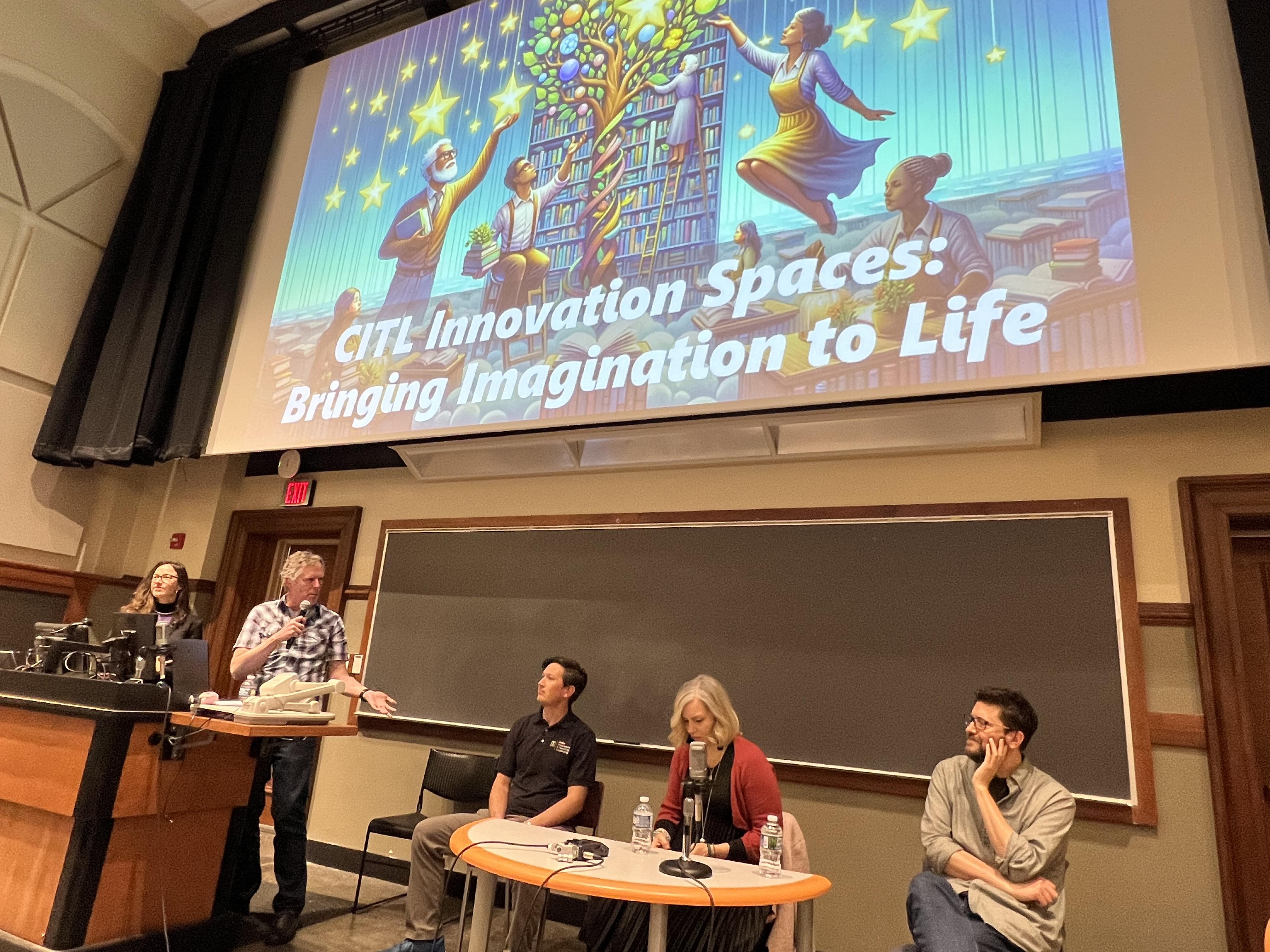
Photo caption: Second from left, Jamie Nelson, Associate Director of Educational Innovation at the Center for Innovation in Teaching & Learning (CITL), introduces members of a CITL panel at the Playful by Design Fall 2023 Symposium. Nelson served as moderator, and the other panelists were (l to r) Rochele Gloor (CITL), Bob Dignan (CITL), Chiara Vincenzi (Art + Design), Chris Fraley (Psychology), and John Toenjes (not pictured).
By Bruce Adams, Contributing Writer
How are faculty members at the University of Illinois Urbana-Champaign transforming education and engaging learners through technological innovation? And how can the Innovation Studio at the Center for Innovation in Teaching & Learning (CITL) assist in these efforts?
Recently, three Illinois faculty members shared how they’ve leveraged emerging tech in the Innovation Studio, located at 172 Armory Building, to teach about fashion design and artistic figures throughout history and prototype a shock generator.
They did so at a CITL panel discussion featured at the Playful By Design 2023 Fall Symposium, held November 2-4 at the University of Illinois. Playful by Design is a community network that includes Illinois faculty, staff, students, and members of the greater Champaign-Urbana community who study, design, and develop games, emerging technologies, and playful/gameful pedagogies.
CITL Innovation Spaces: Bringing Imagination to Life was moderated by Jamie Nelson, the center’s Associate Director of Educational Innovation. Panelists included Professor John Toenjes (Dance), Clinical Assistant Professor Chiara Vincenzi (Art + Design), Professor R. Chris Fraley (Psychology), Bob Dignan (CITL) and Rochele Gloor (CITL).
Vincenzi, who is also an Italian fashion designer and textile artist, started the discussion, sharing that she brings her Fashion Illustration class to the Innovation Studio for 3-hour, small group sessions.
She demonstrated how students design dresses in a virtual, 360-degree environment using the Google open-source program Open Brush. This led to using the Grainger Engineering Library Idea Lab-designed Komodo VR classroom to present and critique work.
She concluded her presentation with a super spooky montage of students’ Halloween-themed dress designs.
Next up was Toenjes, who is also the undergraduate director of Dance at Illinois. He noted that gaming is more popular among young people than theater and that video games offer agency and immersion to players.
Toenjes presented his VR Dance Application “Master Dancer,” fresh from the DRHA (Digital Research in the Humanities and Arts) conference in Turin, Italy. Loie Fuller, an American dancer and lighting designer who achieved worldwide fame at the turn of the last century, provided the model for the Master Dancer VR space and lessons as students move across a Gilded Age theater to direct a Loie Fuller character and learn the creative movement principles of Rudolf Laban. The Innovation Studio helped Toenjes and his multidisciplinary teamwork with ever-changing virtual reality technology and connected them with resources across campus.
Then, these questions were posed: Why is psychological research so dull when psychology is such a fascinating subject? What really happened in room 154?
Fraley attempted to answer them in his presentation. His answers were a combination of an escape room game, a game resembling Clue, and a “shock machine,” constructed in collaboration with the Innovation Studio and the Facilities and Services woodshop. Fraley and Gloor, the Innovation Studio Designer at CITL, used the shock machine to replicate the famous Milgram experiment, making psychological research looked a lot more interesting.
The panel discussion concluded with Dignan, Associate Director for Instructional Media Resources at CITL, showing Generative Artificial intelligence-created images, prompted by typing in the names of well-known movies. This activity allowed the audience to observe the strengths and shortcomings of AI and participate by guessing what film each image represented.
Do you want to learn more about Generative AI and how you can use it in your teaching and learning? Schedule an appointment in the Innovation Studio (172 Armory Building) for a training or consultation from 12 to 4 pm on Mondays and Tuesdays. We also welcome walk-ins during that time.